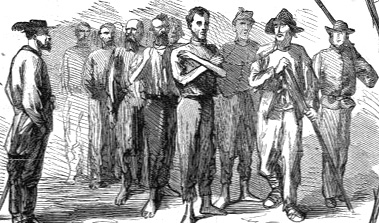
Readers of Dickinson quickly learn not to look for one-to-one analogies between specific historical events or biographical figures and the distilled terms in her highly condensed poems, fragments, and letter-poems. Instead, she encourages us to work with each word and imagine it in a variety of actual and metaphorical contexts. When she deploys imagery of containment, captivity, imprisonment, and liberation, she encourages us to think in both very abstract and very material, concrete ways about what these words suggest. In her earliest poems, Dickinson is
already testing out the figure of the prisoner and identifying herself
with one:
In an 1864 letter to Thomas Wentworth Higginson that refers directly to Higginson's war experiences, Dickinson seems to write lightheartedly about the writer's self-imposed seclusion: "I work in my Prison," she says, and jokes that her dog does not accompany her because "he would die in Jail." But elsewhere, incarceration is "sweet," perhaps involving willing surrender to another in love. She tests out the idea that being captive-- whether to a higher authority, to the process of writing, or to another--might in fact be a means to reach a higher level of consciousness, a privileged state: "A prison gets to be a friend," she writes in another poem written during the War period. A short epigram, "No prisoner be," also implies that captivity and liberation should be understood as emotional states. But the poems Dickinson wrote during the later years of the War also depart from the grim, concrete facts of suffering and death in the camps and fields that were so graphically illustrated for her in the media. Like other observers, she speculates in "He fought like those Who've nought to lose" that dying in battle might be preferable to living under such adverse conditions. In Dickinsonian fashion, this poem, like "Dying! To be afraid of thee" makes us think not only about the condition of the soldier, but about... [MISSING TEXT HERE] Of course, there were many sources for Dickinson's thinking about confinement. The prison narratives of the Civil War joined other forms of captivity narratives familiar to nineteenth-century Americans: true stories of the redeemed Indian captive, of the escaped slave who brings valuable testimony to the cause of abolition. Both of these genres tended to have a religious orientation, as the speaker identifies with Biblical captives (Moses and the Israelites; the Apostle Paul) who were persecuted for their faith but later rewarded by God's grace. The Calvinist tradition tended to see life itself as a form of bondage, and death in Christ as the ultimate liberation. In addition, there is a particularly strong tradition among women poets of the period of thematizing the joy of a captive set free, which Cheryl Walker and other feminist critics have read in light of women's very limited life choices. The theme of containment is often echoed in the very style of Dickinson's writing: she writes in corners, in cramped spaces on the bottoms of pages, in the margins. Recent editorial work by Marta Werner, Martha Nell Smith, and others encourages us to see these as deliberate choices. Here, again, we can see Dickinson turning the state of being "shut up" in a small space into a way of enriching the imagination: it is as if she hurls her writing into smaller and smaller arenas in order to test its limits and make it suggest infinite meanings.  * Initial illustration: Union Pow Camp at Fourt Douglas, outside Chicago, Illinois, 1864 [back] |

 The sense of impotence and personal failure makes readers wonder how Dickinson
defined her own "bars." The myth of Dickinson as the "madwoman in the attic"
presumes that she felt entrapped by limitations she felt imposed upon her
by her family, by social conventions about womanly behavior, or by religious
orthodoxy, and that in response she made herself a kind of willing
prisoner in her room. Yet her poems reveal a far more complex and ambiguous
response to these issues. In one of her best-known pieces, which begins,
The sense of impotence and personal failure makes readers wonder how Dickinson
defined her own "bars." The myth of Dickinson as the "madwoman in the attic"
presumes that she felt entrapped by limitations she felt imposed upon her
by her family, by social conventions about womanly behavior, or by religious
orthodoxy, and that in response she made herself a kind of willing
prisoner in her room. Yet her poems reveal a far more complex and ambiguous
response to these issues. In one of her best-known pieces, which begins,